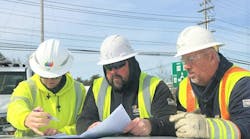This was an ugly, mean, vicious storm that perched itself over the high-density population centers of the Northeast to grind down New Jersey, Connecticut and Long Island, New York. And because Sandy slowed as she hit land, she stacked three successive high tides on top of one another causing unprecedented surge damage.
Sandy wrecked havoc on more than property. She damaged and destroyed lives. Seeing the large-scale devastation, whether in person or on television, we all found out that we are not as secure, as insulated, as protected from life as we once thought. We are just one event away from a life forever altered.
How did we respond? Our line workers and field personnel hit it with all they had, working 16-hour days, working in wind, rain and snow. These linemen and tree trimmers are tough. And they care. Linemen never feel more alive or more appreciated than when responding to downed lines. It's in their DNA.
Storms are in my DNA, too. I had to get up there and cover this rebuild. Having covered Katrina and Ike, I knew the mainstream press will never give our industry a fair shake. So I had to go to report on the rebuild from ground zero.
I flew into the Islip Airport on Long Island, having earlier put in a call to Nick Lizanich, vice president of power delivery for the Long Island Power Authority (LIPA). Lizanich is a veteran utility person, having worked at both FirstEnergy and ComEd in operations roles, so I knew LIPA would have its game on.
After Hurricane Irene hit this same area in 2011, LIPA had reworked its processes and streamlined its safety training, logistics handling and work dispatch processes, so now it was able to scale up to handle the some 11,000 crews working on the island at the peak of the Sandy rebuild.
Upon arrival, crews were instructed on LIPA safety practices while representatives were brought to the logistics center to receive work and lodging assignments. Because of the extent of damage, the responsibility to restore 81 of the hardest-hit areas was handled on a substation basis, with crews focusing their early efforts on rebuilding major feeders.
LIPA is a state agency that outsources most of its routine functions to National Grid while retaining ownership of the assets. Amazingly, the support staff at National Grid always managed to keep sufficient poles, transformers, switches and hardware on hand to keep the crews working. This is quite an accomplishment, so kudos to the purchasing folk, who seldom get the credit when things go smooth.
Out in the field, I snapped photos of linemen setting poles, hanging transformers and pulling in wire, all in a steady rain — a scene that was repeating itself all over the island.
I also sat in on one of LIPA's daily situational awareness calls, held in the LIPA headquarters in Hicksville, New York. Incident Commander John Bruckner took calls as progress was reported from each region. He and his team then provided additional assistance and assignment adjustments, depending on progress made the day before. I was witnessing alignment from top to bottom in responding to this storm.
In the midafternoon, I took the Port Jefferson Ferry to Bridgeport, Connecticut, and then traveled three hours by car over back roads through the blinding snow of a Nor'easter to Berlin, Connecticut, the headquarters of Connecticut Light & Power (CL&P). There I learned that CL&P had located liaison teams in each of its 170 cities. With a line crew and a tree trimming crew at each locality, officials had a direct say in addressing critical situations, whether it was downed, hanging limbs or bringing back critical facilities. This was a smart move as it had local officials involved in the decision-making process.
I traveled with Bill Quinlan, CL&P's senior vice president of emergency preparedness, to the state emergency operations center in Hartford. Bill Hackett, the state's director of emergency management and homeland security, had gathered storm-response organizations, including FEMA and the State Highway Department as well as gas, water, electric and telecom companies. With all major rebuild parties in the same room, they were able to make critical decisions quickly. Each day, Connecticut Gov. Dannel Malloy received reports from the various entities responsible for all the infrastructure being rebuilt and followed up with a conference call to update all local officials in the state.
Now back from the front, I've had time to gain a little perspective. Both LIPA and CL&P are learning, adaptive organizations. Both were prepared to scale up to respond to major events. Both had access to information systems that carried them through all aspects of restoration. Both had men and women who gave this storm all that they had. You can't ask for more than everything.
I can't adequately put into words just how proud I am of our manufacturers, our contracting firms and our utility brethren who responded so gallantly to this storm bent on destruction.
In 2013, we will provide more information on the rebuild, including work performed in New Jersey and at Con Edison.



